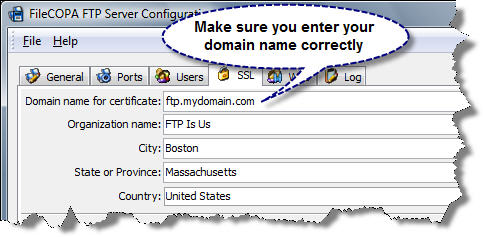How do I configure SSL with the FileCOPA FTP Server Software?
You will need a certificate in order to run a secure site with the FileCOPA FTP Server Software. You can get certificates from many places including Verisign, Globalsign and FreeSSL. FreeSSL will allow you to get an SSL certificate free to try for 30 days.
Your chosen certificate provider will require a CSR (Certificate Signing Request) which is an encrypted block of data that contains the name of the server you wish to use the certificate on, your business name and your physical location.
To generate a CSR load the FileCOPA FTP Server Software Control Panel and go to the SSL tab. Enter your details for your domain.

It is very important that you get the domain name correct. This should be the name you type into an FTP client to access the site, eg ftp.mydomain.com. If you do not get this correct then ftp clients will display a warning that the certificate is invalid when they connect to you. Once you have done this click the button marked Generate CSR.

This will display the CSR that your certificate authority will require you to give them.
Once verified, your certificate provider will send a certificate to you. This usually arrives as a block of text that starts with -----BEGIN CERTIFICATE----- and ends with -----END CERTIFICATE-----.
To add the certificate, press the "Paste from Clipboard" button on the SSL page of the FileCOPA FTP Server Software controller. This will open the Add SSL Certificate window. Next paste the certificate text that was sent to you by your certificate provider. You must paste everything from, and including the -----BEGIN CERTIFICATE----- line through and including the -----END CERTIFICATE----- line.
Press the OK button and your certificate will be added to the FileCOPA FTP Server Software configuration.